I am an active part of two research efforts at Purdue, the Hardwood Tree Improvement and Regeneration Center (HTIRC) and the Hardwood Ecosystem Experiment (HEE). My work as part of the HTIRC centers on understanding how disturbance and invasive species affect the regeneration and sustainability of hardwood forests. My work with collaborators from the HEE has sought to understand how forest management interacts with other disturbances to influence multiple taxa within the forest. Some selected areas of research are described in more detail below.
Effects and control of invasive woody plants
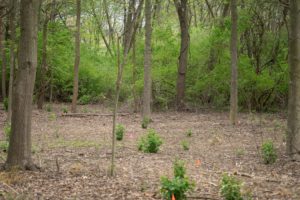
Woody invasive plants from East Asia have become a serious problem in many forests of eastern North America. We have studied how these species, with an emphasis on Amur honeysuckle (Lonicera maackii), affect native herbaceous-layer species, forest regeneration, and small mammal populations. We have also examined the interactive effects of invasive shrubs and white-tailed deer on forest communities. Currently, we are examining the effectiveness of different control techniques, while also examining how these techniques affect above and belowground community composition and function.
Effects of invasive insects and disease in eastern forests
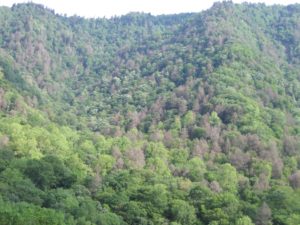 Unfortunately, the forests of eastern North America have a long and tragic history of invasion by non-native insects and pathogens. Starting with chestnut blight in the early 1900s, and continuing with hemlock woolly adelgid and emerald ash borer today, our forests have been forever changed through the loss of foundation tree species. We continue to study how the loss of forest tree species affect the composition, structure, and function of plant communities. Recent work has examined how the loss of eastern hemlock in the southern Appalachian Mountains has changed the successional trajectory of different forest types. Future work will include using long-term data to assess how Central Hardwood Forests are changing in response to emerald ash borer.
Unfortunately, the forests of eastern North America have a long and tragic history of invasion by non-native insects and pathogens. Starting with chestnut blight in the early 1900s, and continuing with hemlock woolly adelgid and emerald ash borer today, our forests have been forever changed through the loss of foundation tree species. We continue to study how the loss of forest tree species affect the composition, structure, and function of plant communities. Recent work has examined how the loss of eastern hemlock in the southern Appalachian Mountains has changed the successional trajectory of different forest types. Future work will include using long-term data to assess how Central Hardwood Forests are changing in response to emerald ash borer.
Plant community response to herbivory by white-tailed deer
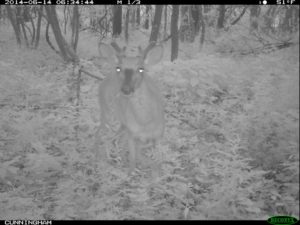 Fragmented landscapes in many parts of eastern North America offer near optimal habitat for white-tailed deer, and in many areas deer populations are at historic highs. To understand how deer herbivory affects forest plants, we have research projects underway in Indiana and Great Smoky Mountains National Park. We are examining the effects of deer herbivory at scales ranging from individual populations to landscapes. We are also working with collaborators at Purdue to understand how the effects of deer vary with landscape context across the state of Indiana, and how people perceive the abundance and effects of deer.
Fragmented landscapes in many parts of eastern North America offer near optimal habitat for white-tailed deer, and in many areas deer populations are at historic highs. To understand how deer herbivory affects forest plants, we have research projects underway in Indiana and Great Smoky Mountains National Park. We are examining the effects of deer herbivory at scales ranging from individual populations to landscapes. We are also working with collaborators at Purdue to understand how the effects of deer vary with landscape context across the state of Indiana, and how people perceive the abundance and effects of deer.
Restoration and dynamics of oak forests
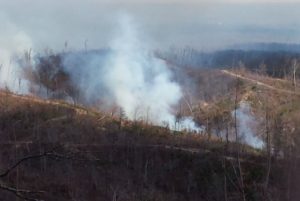 With the suppression of disturbance, oak species are failing to regenerate in forests with they currently dominate the overstory. Instead, succession in these forests is moving towards a future overstory dominated by shade-tolerant species such as red and sugar maple. This is a critical issue for forest scientists and managers because of the great ecological and economic importance of oak species. We are examining successional trends in oak-hardwood forests by analyzing long-term datasets to determine how oak species have responded to past management actions. We are also collaborating with Forest Service scientists and managers to determine how different management techniques can be used in conjunction with surface fire to favor the establishment and persistence of oak regeneration.
With the suppression of disturbance, oak species are failing to regenerate in forests with they currently dominate the overstory. Instead, succession in these forests is moving towards a future overstory dominated by shade-tolerant species such as red and sugar maple. This is a critical issue for forest scientists and managers because of the great ecological and economic importance of oak species. We are examining successional trends in oak-hardwood forests by analyzing long-term datasets to determine how oak species have responded to past management actions. We are also collaborating with Forest Service scientists and managers to determine how different management techniques can be used in conjunction with surface fire to favor the establishment and persistence of oak regeneration.
Long-term change in old-growth hardwood forests
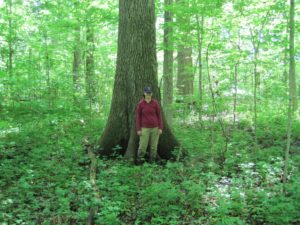 Old-growth forests are rare across the landscape, where they often occur as small isolated tracts surrounded by younger forests or other land uses including agriculture and development. Understanding the long-term dynamics of old-growth forests is important to their preservation. In addition, these forests can serve as benchmarks for how younger forests may develop in the future. We use long-term datasets to track changes in old-growth forests throughout the Central Hardwood Region. Ongoing efforts are examining carbon sequestration in old-growth forests across a regional productivity gradient in the Midwest.
Old-growth forests are rare across the landscape, where they often occur as small isolated tracts surrounded by younger forests or other land uses including agriculture and development. Understanding the long-term dynamics of old-growth forests is important to their preservation. In addition, these forests can serve as benchmarks for how younger forests may develop in the future. We use long-term datasets to track changes in old-growth forests throughout the Central Hardwood Region. Ongoing efforts are examining carbon sequestration in old-growth forests across a regional productivity gradient in the Midwest.
Response of Trillium populations to disturbance
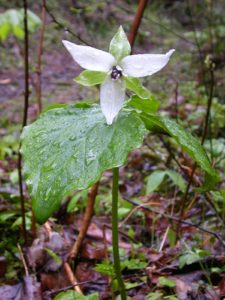 While forestry research has traditionally focused on tree species, the herbaceous layer of forests often contains most of the plant diversity in forests and plays a critical role in many ecosystem processes. In addition, many herbaceous perennials are long lived and display population-scale effects of historic disturbance. Members of the genus Trillium offer an excellent opportunity for study because they can live for multiple decades and individual plants can be aged by counting stem scars on the rhizome, allowing for demographic studies of extant populations. In Great Smoky Mountains National Park, we have examined Trillium populations to determine their response to historic logging and herbivory by overabundant deer populations. We have used fine-scale mapping to examine the spatial patterning of populations in both secondary and primary forests.
While forestry research has traditionally focused on tree species, the herbaceous layer of forests often contains most of the plant diversity in forests and plays a critical role in many ecosystem processes. In addition, many herbaceous perennials are long lived and display population-scale effects of historic disturbance. Members of the genus Trillium offer an excellent opportunity for study because they can live for multiple decades and individual plants can be aged by counting stem scars on the rhizome, allowing for demographic studies of extant populations. In Great Smoky Mountains National Park, we have examined Trillium populations to determine their response to historic logging and herbivory by overabundant deer populations. We have used fine-scale mapping to examine the spatial patterning of populations in both secondary and primary forests.


